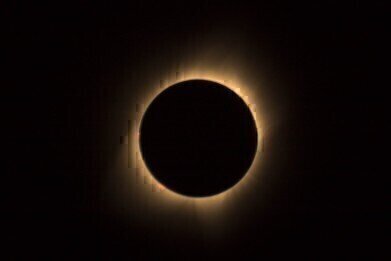News & Views
What Are the 5 Stages of a Total Solar Eclipse?
Mar 16 2015
Many people will be heading to the Northern parts of Scotland on the 20th of March this year, to see the stunning solar eclipse. Why exactly? Because one of the best places to view the eclipse in Europe has been named as the coastal city of Torry Battery in Aberdeen. But what happens when a total eclipse takes place? There are five different stages during a total eclipse.
First Contact
A total eclipse begins with first contact (or partial eclipse). This is when the Moon starts to travel across the face of the Sun. At this stage, the eclipse looks like a ‘bite’ has been taken out of the Sun.
During first contact, and for the next hour and a half, the skies will begin to darken and diminish as the Moon starts to make its way across the surface of the Sun.
Just before the second phase of the eclipse, undulating lines of light can be seen called ‘shadow bands’.
Second Contact
The next phase is second contact and happens a few minutes before totality. You may be aware of changes in wildlife around you throughout this phase. Birds may stop singing as the skies darken, and some animals may exhibit changes in eating or sleeping patterns.
Towards the end of this phase you may observe the phenomenon of Baily’s Beads. These are distinct balls of light visible at the edge of the Moon’s circumference.
Baily’s Beads are caused by the Sun shining through craters on the surface of the Moon. These beads will flicker off one by one until one solitary point of light remains. This is known as the Diamond Ring effect. This effect last just seconds but produces one stunning single burst of light.
Once this is gone totality begins.
Totality
Totality takes place when the Moon covers the entire surface of the Sun. At this point in time, only the Sun’s corona is visible. The skies darken even further, but not as dark as a typical night.
There is a distinct drop in temperature and birds and other wildlife are silent.
If the Sun’s solar activity is strong, the corona will blast out from all sides of Moon. If it is weak, it will follow the direction of the Sun’s magnetic path.
This stage lasts around two minutes.
Third Contact
The fourth stage is much like the second and first but in reverse. Now the Moon is moving away from the Moon as the Diamond ring may be observed again. Baily’s beads reappear, which are then followed by a thin crescent of the Sun which gradually gets bigger as the Moon moves away. Shadow bands may be observed once again and we are back to the partial eclipse stage. The skies start to lighten and wildlife begin to be more active.
Fourth Contact
Finally, the last stages of the eclipse occur and the Moon completely leaves the face of the Sun, and the full disc is visible. The last shadow on the Sun disappears at the moment of the Fourth Contact.
Europe’s biggest solar eclipse…
Europe’s biggest solar eclipse since 1999 is set to occur on the 20th March this year. Experts estimate that nearly 90 per cent of sunlight will be blocked over parts of Europe, with London experiencing 84 per cent less light. If you’re planning on seeing the solar eclipse, here’s the best way to safely watch it.
Digital Edition
Lab Asia 31.2 April 2024
April 2024
In This Edition Chromatography Articles - Approaches to troubleshooting an SPE method for the analysis of oligonucleotides (pt i) - High-precision liquid flow processes demand full fluidic c...
View all digital editions
Events
Apr 28 2024 Montreal, Quebec, Canada
May 05 2024 Seville, Spain
InformEx Zone at CPhl North America
May 07 2024 Pennsylvania, PA, USA
May 14 2024 Oklahoma City, OK, USA
May 15 2024 Birmingham, UK


















